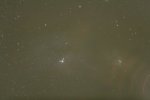Hello,
First post here.
I just got some data on M108 and the Owl Nebula recently and all of my subs after the pier flip look okay:

But all my subs before the pier flip have weird streaks of light on one side. Here's an example:

Most of the subs I have are from before the pier flip and because of this, when I integrate my subs, these streaks really stand out:

I talked to a few friends about this and we came to the conclusion that these were streaks of light were caused by some internal reflection from the light of Merak (just out of my FOV).
So my question is, other than DBE/ABE (already tried out), is there something I can do to get rid of/minimize the effect these streaks? I tried performing Local Normalization as part of my integration process, and that helped a little but, but not much.
Any ideas?
First post here.
I just got some data on M108 and the Owl Nebula recently and all of my subs after the pier flip look okay:

But all my subs before the pier flip have weird streaks of light on one side. Here's an example:

Most of the subs I have are from before the pier flip and because of this, when I integrate my subs, these streaks really stand out:

I talked to a few friends about this and we came to the conclusion that these were streaks of light were caused by some internal reflection from the light of Merak (just out of my FOV).
So my question is, other than DBE/ABE (already tried out), is there something I can do to get rid of/minimize the effect these streaks? I tried performing Local Normalization as part of my integration process, and that helped a little but, but not much.
Any ideas?


